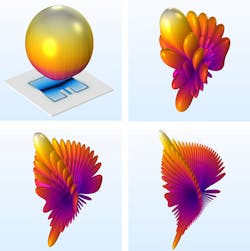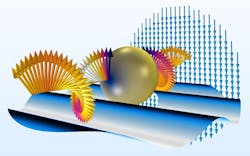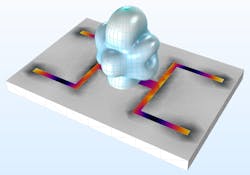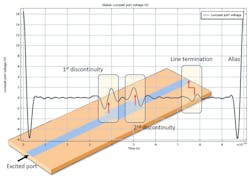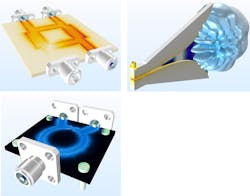Software Tool Promotes Faster Antenna Evaluation and More
Download this article in PDF format.
5G will likely induce a fundamental shift in a number of markets, including communication, automotive, Internet of Things (IoT), and virtual reality. Simulation and design engineers can address the architecture required to design applications that will bring the network to life using multiphysics modeling. The latest features introduced in the RF Module, a high-frequency electromagnetic (EM) simulation add-on tool that’s now available in COMSOL Multiphysics version 5.4, will ultimately lead to more efficient product design for RF/microwave engineers. Highlights include:
- Postprocessing workflows and variables for antenna-array radiation-pattern analysis
- Simulation domain transformation utilizing time-to-frequency and frequency-to-time fast Fourier transform (FFT)
- Expanded material library for microwave and millimeter-wave (mmWave) circuit boards
- Application library updates through the deployment of commercially available connectors in the RF Part Library
Uniform Antenna-Array Postprocessing
An antenna array consists of two or more antennas in which signals are combined, thus improving performance in comparison to that of a single antenna. Utilizing an antenna array offers various benefits. An array can increase overall gain, provide reception diversity, eliminate interference, and steer the beam in a particular direction, among other aspects.
The radiation pattern of an antenna array can be quickly evaluated from the radiation pattern of a single antenna element by using an asymptotic approach (Fig. 1). This approach multiplies the far field of a single antenna with a uniform array factor during postprocessing. Including just a line of expression during the postprocessing can deliver the visualization of the far-field radiation pattern for an arbitrary number of antenna arrays without running the simulation again. The ability to efficiently visualize and analyze a number of antenna arrays has become more important with the impending 5G network, which will enable multi-beam multiplexing and massive multiple-input, multiple-output (MIMO) technologies.
1. A single microstrip patch-antenna simulation can be extended to estimate antenna-array performance. Synthesized radiation patterns for 8-×-8, 16-×-16, and 32-×-32 arrays are plotted.
Effective 3D Far-Field and RCS Functions
With the antenna array optimized and ready to go, we can use it to perform a radar-cross-section (RCS) analysis. The RCS characteristics are largely influenced by the electrical size and nature of the target subjected to the radar beam. To achieve accurate results, we must analyze the problem by solving full-wave equations. 3D full-wave equations often require a great deal of computational resources. To ensure accuracy without compromising computational speed, a far-field analysis of a 3D model can be performed by running an equivalent 2D axisymmetric model (Fig. 2).
2. This is a 3D representation of a 2D axisymmetric model. Through a 2D axisymmetric model with a circularly polarized background field, it’s possible to estimate the scattered field response of a 3D sphere excited by a linearly polarized background field.
With the introduction of the latest version of COMSOL Multiphysics, 3D far-field norm functions are available in 2D axisymmetric models for the following cases:
- Antenna models excited with circular port type and a positive azimuthal mode number
- Scattered field or RCS analysis computed with the predefined circularly polarized background field
Wideband Far-Field Study Through Time-to-Frequency FFT
Transmitting and receiving calls, text, and data over wider-bandwidth frequency channels have led communication systems designers to look at multi-band frequencies and their available bandwidths to deliver the communication speeds anticipated for the future. By using simulation tools, engineers can analyze a wideband frequency-domain antenna far-field pattern in the time-domain physics interface, facilitating faster communication speeds for numerous technologies.
Frequency-domain analysis delivers one result point per frequency. To obtain the results over multiple frequency points, one must run the simulation multiple times in the frequency domain. Therefore, computational time is proportional to the number of frequency points.
However, combining time-to-frequency and FFT will allow for a wideband simulation with a very fine frequency resolution, essentially eliminating the need to run multiple analyses with one simulation (Fig. 3). Using this technique, a single simulation in the time domain can achieve a wideband frequency-domain simulation with many frequency steps.
3. The far-field radiation pattern at the second resonance is visualized for a printed dual-band antenna strip model. The electric-field norm distribution is also added.
Virtual Network Analyzer Functionality
The most conventional RF and microwave circuit examples are eventually computed in the frequency domain to calculate S-parameters. To address signal-integrity (SI) problems with regard to time-domain reflectometry (TDR), though, the analyses may require additional transient computation.
Using the frequency-to-time FFT combined with the frequency-domain study, it’s possible to perform TDR analysis. The impedance discontinuities and mismatches on a transmission line can be identified by examining the signal-quality variation in the TDR (Fig. 4). This allows for more efficient analysis of cables and optical fibers, for example.
4. This is a defective microstrip line model analyzed with frequency-to-time FFT. The overshoot and undershoot of the signal in the 1D plot describe the discontinuities of the microstrip line.
Additional Substrates in the RF Material Library
As antenna designs become more complex to meet the diverse and demanding needs of the market, the RF Module material library has expanded to include more than 100 substrate materials for modeling printed RF, microwave, and mmWave circuits (Fig. 5). In addition, more than 40 substrate materials from the Isola Group were added in this release to support work on circuit board design.
5. COMSOL expanded the RF Material Library for circuit-board simulation.
Updated Application Library with Commercial Connectors
A design task, such as repeatedly setting up identical geometry sequences, can be simplified by utilizing the RF Part Library. The Part Library contains partially parameterized complex shapes, such as connectors, surface-mount devices, and waveguides, that are useful for circuit and antenna simulations. Predefined selections—a group of boundaries—in each part help to easily define the conductive boundary while setting up the physics. A few Application Library examples have been updated to demonstrate the usage of these parts (Fig. 6).
6. Shown are an SMA connectorized branch-line coupler, a double-ridged horn antenna, and a Wilkinson power divider.
Visit https://www.comsol.com/release/5.4/rf-module for the full details regarding 5.4 updates in the RF Module.
Jiyoun Munn is RF Technical Product Manager at COMSOL.
About the Author
Jiyoun Munn
Technical Product Manager, COMSOL Inc.
Jiyoun Munn is the technical product manager for the RF Module at COMSOL, and a senior member of IEEE. He has two decades of experience in the RF industry, developing over 150 antenna and microwave device prototypes. Munn also holds patents for antenna interrogation systems. He received his MS degree in electrical engineering from the University of Michigan.

